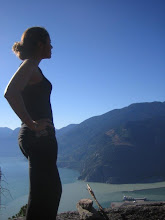skip to main |
skip to sidebar


Cod, A biography of the fish that changed the world. By, Mark Kurlansky

This work is licensed under a Creative Commons Attribution-Noncommercial-No Derivative Works 3.0 Unported License.
Taking a look at the environmental footprints that we have left behind as well as the road ahead.
Whales being attacked by seagulls.
Posted by
Kait
on Wednesday, 5 August 2009
Labels:
ocean,
whales
Another threat to the survival of southern right whales off the coast of Argentina has been added to the list; seagull attacks.
As the whales surfaces the gulls land and peck through the skin in search of blubber, which is an important source of calories. The bites leave big open wounds, which can reach a half a meter across and have a possibility of transmitting germs. This is not the first time that these attacks have been witnessed. "The attacks around Peninsula Valdes were first noted about 35 years ago but systematic studies have only recently begun. The proportion of whales attacked annually has soared from 1% in 1974 to 78% today"1.
The attacks focus on mothers and calves, as they spend more time at the surface and the calves have softer skin. "The gulls attack force whales to dive and flee, interrupting resting and feeding periods. The animals lose energy normally used to fatten for long migrations or milk production"2. "The mothers spend less time nursing, and we're seeing thinner calves"3.
The gull populations increased with the supply of food from landfills and development of fish processing plants in the areas. Researches fear that if the problem of the gulls is not solved the whales will attempt to travel elsewhere where they could be placing themselves in greater danger.
1. http://news.bbc.co.uk/2/hi/science/nature/8116551.stm
2. Marcelo Bertellotti of Argentina's Patagonia University. http://news.softpedia.com
3. Roxana Schteinbarg Director of the Instituto de Conservacion de Ballenas. http://news.bbc.co.uk/2/hi/science/nature/8116551.stm

Another threat to the survival of southern right whales off the coast of Argentina has been added to the list; seagull attacks.
As the whales surfaces the gulls land and peck through the skin in search of blubber, which is an important source of calories. The bites leave big open wounds, which can reach a half a meter across and have a possibility of transmitting germs. This is not the first time that these attacks have been witnessed. "The attacks around Peninsula Valdes were first noted about 35 years ago but systematic studies have only recently begun. The proportion of whales attacked annually has soared from 1% in 1974 to 78% today"1.
The attacks focus on mothers and calves, as they spend more time at the surface and the calves have softer skin. "The gulls attack force whales to dive and flee, interrupting resting and feeding periods. The animals lose energy normally used to fatten for long migrations or milk production"2. "The mothers spend less time nursing, and we're seeing thinner calves"3.
The gull populations increased with the supply of food from landfills and development of fish processing plants in the areas. Researches fear that if the problem of the gulls is not solved the whales will attempt to travel elsewhere where they could be placing themselves in greater danger.
1. http://news.bbc.co.uk/2/hi/science/nature/8116551.stm
2. Marcelo Bertellotti of Argentina's Patagonia University. http://news.softpedia.com
3. Roxana Schteinbarg Director of the Instituto de Conservacion de Ballenas. http://news.bbc.co.uk/2/hi/science/nature/8116551.stm
About Me

- Kait
- I am a 20 something Canadian woman currently living in Vancouver. I am greatly interested in assisting in the search for solutions for global environmental sustainability. It's time we all took personal responsibility for the state of our environment.
Search this blog
Currently Reading...

Cod, A biography of the fish that changed the world. By, Mark Kurlansky
Books of '11
- • Four Fish. By, Paul Greenberg
- • Environmental Law. By, Jamie Benidicson
- • Long Term Value Strategy for the Canadian Lobster Industry. By, Gardner Pinfold Market Research Associates
Books of '10
- • Fisheries Economics an introduction. By, Stephen Cunningham, Michael R. Dunn, and David Whitmarsh
- • Tar Sands. Dirty Oil and the Future of a Continent. By, Andrew Nikiforuk
- • Guns, Germs, and Steel. The Fates of Human Societies. By, Jared Diamond.
- • The End of Food. By, Paul Roberts
Books of '09
- • Silent Spring. By, Rachel Carson
- • Sea Sick, the Global Ocean in Crisis. By, Alanna Mitchell
- • The world without us. By, Alan Weisman
- • Bottomfeeder. How to eat ethically in a world of vanashing seafood. By, Taras Grescoe
- • Life in 2030: Exploring a Sustainable Future for Canada. By, John B. Robinson
- • The Whale Warriors. The battle at the bottom of the world to save the planet's largest mammals. By, Peter Heller
- • In a perfect ocean. The state of fisheries and ecosystems in the north atlantic ocean. By, Daniel Pauly and Jay Maclean
- • The end of the line. How overfishing is changing the world and what we eat. By, Charles Clover
Favorite Posts
Labels
- climate change (5)
- coast (1)
- Dear Korea... (2)
- energy (2)
- finning (2)
- fish (10)
- fisheries (9)
- garbage island (2)
- green building (1)
- Guest post (2)
- hypoxia (1)
- Interesting people (5)
- longlines (1)
- movies (1)
- ocean (19)
- organic (1)
- paper (3)
- plastic (4)
- recycling (6)
- seafood (6)
- shark (2)
- water (4)
- whales (1)
Blog Roll
Followers
Visitors
This work is licensed under a Creative Commons Attribution-Noncommercial-No Derivative Works 3.0 Unported License.




0 comments:
Post a Comment